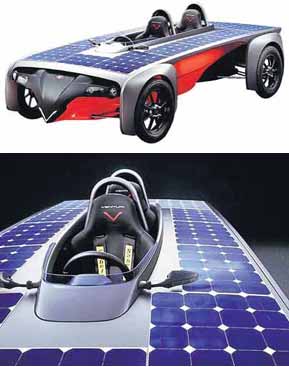|
Venturi
Astrolab
|
|
The Venturi Astrolab will
be the first solar-electric hybrid car to hit the market
when it rolls out in January 2008. Though it may appear
to be, the Venturi Astrolab is not a concept car, but
will rollout as a full production zero emission vehicle
with a cool price tag of around $117,000.
The Venturi Astrolab uses
photovoltaic cells with an impressive 21-percent yield
and the company believes even greater yields can be achieved
in the years to come.
|
Though the price tag is steep, the novelty and wow factor will
certainly make the Venturi Astrolab a force to be reckoned with
if the public demand for this French vehicle is as sustainable
as the car itself. Considering the solar vehicle is covered
with 3.6 meters of photovoltaic cells, (nano-prisms) which provides
enough oomph for the car to achieve a top speed of around 74
mph, that's pretty impressive for something that looks like
it should be competing in the 2006 Michelin Challenge Bibendum
sustainable fuel competition or displayed at an auto show for
concept vehicles.
|
|

Venturi
Astrolab Solar-Electric Hybrid Car
|
The Venturi Astrolab contains a small 16 kw engine and
does not need permanent sun exposure in order to move. Power
is also supplied by the last generation nickel metal hydride
batteries (NiMH) NIV-7, which are liquid cooled and can
be plugged in using its onboard charger. A full recharge
takes about 5 hours and the batteries are designed to last
for 10 years. There is also the option to use high voltage
outlets 80A / 380Volts and reduce the recharging time. The
minimum range of the vehicle is 68 miles, which one would
assume could be achieved from night driving or driving in
low light conditions. Apparently, there is no maximum range
for sunny conditions or locations.
Designed with an ultra-light carbon monocoque chassis,
the Venturi Astrolab has been likened to a Formula 1 racecar,
a sailboat and a flying wing on four wheels. Whatever the
analogy, the Venturi Astrolab is lightweight, quiet running
and emits no greenhouse gases. In addition, the Venturi
Astrolab is a 2-seater encompassed by an oversized protection
cell in case of a collision and takes the passengers' weight
into account during its dynamic operation.
When looking at the photos of the Venturi Astrolab it appears
there is no glass to cover the driver's and passenger's
heads and that the automobile is not equipped with doors.
So, we asked Venturi's Service Marketing Manager Jean-René
Ricord about this. According to Mr. Ricord, "The car
won't be available with any glass covering for the moment."
Ricord goes onto say, "There won't be any doors on
Astrolab. To get in the car, you just put a carbon board
on one of the 2 sides of the car, then you sit on it and
pass your legs in the car. It's a bit sporty but very funny."
Funny or not, many eyes will be on this vehicle in the next
couple of years in regards to performance and popularity
when it finally hits the showrooms.
|


